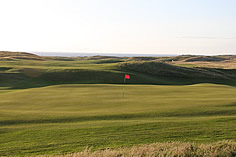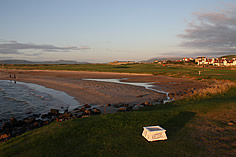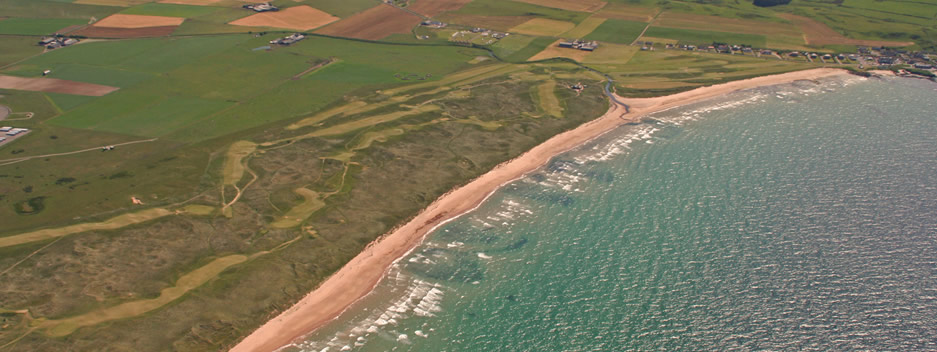Can there be finer opening first hole in golf?
There are some great ninth holes around the world, plenty of superb 10th holes, certainly one captivating 17th hole and countless thrilling final holes.
But as Bernie McGuire long ago discovered the first at Machrihanish has to be one of the finest first holes in all of golf.
The first thing you want to do in stepping onto the first tee at Machrihanish Golf Club on the Scottish south-west coast is not reach for the driver but grab your camera.
It’s a picture postcard setting with Machrihanish Bay and the breathtaking expanse of the Atlantic Ocean to your left, and in front the curving shape of a golden Machrihanish beach.
And somewhere amid this idyllic setting is a fairway. Named ‘Battery’, it’s a 423-yard straight-up test of moral fibre and game.
The question is how much do you bite off?
Play safe and it’s still a long second shot to the green. Get greedy and you next could be from a sandy lie.
However it’s not all gloom because some of the best golfers to have competed at Machrinhanish have managed to salvage par from the beach given it is treated as a lateral hazard and not out-of-bounds.
Machrihanish is about 150 miles from Glasgow but the great thing is there’s no freeway leading directly to this Scottish links gem.
I say this selfishly only because it would only make it a lot easier access to many more golfers to walk this wonderful stretch of golfing land.
As it is, it’s a long drive up the A82 from Glasgow and then a hard drive down the A83 to Campbeltown and then onto Machrinhanish.
Of course there are flights direct from Glasgow to Campbeltown or you could always get permission to fly in by private plane or helicopter landing at the adjoining NATO air base.
For many, the region was rarely visited until Paul McCartney released his hit song ‘Mull of Kintyre’.
But just a note of warning! Don’t expect the wide expanse of a sandy beach when you get to the Mull of Kintyre as it’s a desolate barren outcrop where tragically they’ve added a memorial after an RAF chopper crashed there in 1994.
But no matter how you find your way to Machrinhanish it’s a journey where golfing reward beckons.
CLUB HISTORY
The club, initially referred to as the Kintyre Golf Club, was formed on Saturday, 11th March, 1876 when eight gentlemen, two being church ministers and another a Captain in the Militia, met in the Argyil Arms Hotel, at Campbeltown, for the purpose of organising a golf club.
Captain Beatiie Pownall, who attended that first meeting, was stationed in the area and he became the club’s first secretary.
It was agreed the club joining fee would be 10 shillings and annual subs of five shillings.
It was further agreed that ‘the rules of golf in force at Prestwick should be adopted’.
The local Campbeltown Courier reported the formation of the Kintyre Golf Club but remarking: “The game of golf is peculiar to the east of Scotland, but it never succeeded in getting a footing in the west. It is consequently quite a novel game in Campbeltown and it remains to be seen whether it can be successfully carried on.”
However the delight in club celebrating its formation with a game of golf had to be put on hold for some days due to storms and heavy snowfalls.
Finally at 10am on Monday 20th March, 1876 the first games of the Kintyre Golf Club on farming land at Machrinhanish was played over 10 holes.
Among those teeing-up was Reverend George Walter Strange one of the club’s founders who was minister of the Castlehill Church in Campbeltown from 1974 to his death in 1921.
The 14th hole at Machrihanish is named ‘Castlehill’ in his honour.
Within the first years 41 one members joined with Charles Hunter, the then professional at Prestwick, asked to extend the course to 12 holes.
After additional ground had been obtained west of the river, Old Tom Morris was commissioned in 1879 to layout an additional six holes to make the course a full 18 holes.
In July that year, the first formal competition took place with four professionals in Old Tom, Jim Morris and Bob Marin, all from St. Andrews, along with Jack Morris from Hoylake played for the princely sum of £(Stg) 10.
Jim Morris won with a remarkable score of 78 considering the conditions, the type of ball used and the equipment on offer at the time. Bob Martin shot 81, Old Tom 86 and Jack Morris 87.
The match was the start of a week’s celebration with Jack Morris having brought with him a contingent from Hoylake while a big party of golfers from the Glasgow Golf Club also took part.
There was a further competition in December that same year with some of the prizes including: turkeys, hares, gigot of mutton, rabbits, goose, ham, cheese, beer, a hat, tea, and one ball to each who participated except last place.
It was much the same rewards for a competition in October 1882 with the prizes being cheese, ham, a box of cigars, a dozen golf balls, five lambs and a grouse.
There is the bizarre tale of the 1880 Club Captain, Commander Stewart of Knockrioch, donating a dozen ‘Stewart golf balls’ he claimed to have invented, and the first with a rubber core.
However litigation was initiated by the U.S. ball manufacture, Haskells who claimed to be the inventors and they alleged Stewart had breached copyright laws. Stewart was called into the witness box but had evidence rubber core balls were being used at St. Andrews as far back as the 1870s.
Haskells claim was thrown out of court.
The club’s ‘original’ clubhouse had been erected on what is now the 15th hole, and appropriately named ‘The Hut’.
But in 1886 the Committee decided to build a new one and that was opened in February, 1887 before later adding a green keeper’s house and workshop for the club’s professional.
The club moved to its present premises in 1965 with the clubhouse being opened by Lieut. Colonel H.L.R. Macneal for it was the Macneal’s who owned the Lossit Estate on land where the new clubhouse stood.
The Macneal’s were not only generous club benefactors but a Macneal had been club captain on five occasions between 1879 and 1931.
In honour of the Lossit’s the 18th hole is named ‘Lossit’.
Steamship travel and the opening of a light railway from Campbeltown to Machrihanish in the early 1900s brought many more golfers to Machrinhanish.
Also in 1914 the course was altered again when five-time Open champion, J H Taylor was asked to lay out a course that was in operation for close on the next 50 years.
It wasn’t till the Second World War when the Royal Navy acquired a portion of the course as a Fleet Air Arm training centre and later used by R.A. F. Coastal Command, that the course changed.
It meant losing the 8th, 9th and 10th holes but then the services of Sir. Guy Campbell was secured to reword a number of holes so that the club has the course that is there now for all to enjoy.
After the War, permission was granted to British Airways to operate daily flights back and forward to Glasgow.
R. A. F. Machrihanish is still in use today under NATO’s command and those with the resources can land their private aircraft or helicopter.
THE COURSE
 From the outset Machrihanish grabs you by the heart strings.
From the outset Machrihanish grabs you by the heart strings.
Now you’ve put the camera away there’s the choice of playing conservatively and fighting hard for par or the challenge of taking a bigger bite over the beach for the chance of birdie.
But then if you do happen to land of the beach it’s classed as a lateral hazard so you can play off the sand. If so, just be aware of any bathers or beach walkers.
While the first heads in a northerly direction, the second, a par four at 393 yards and with a burn short of the green turns, turns directly west towards the Atlantic and right into the teeth of any wind.
But little has changed to disturb the natural scenic beauty and inspiring challenge at Machrihanish.
If you’ve managed to clear the beach at the first and battled your way up the second then there are more tests to come with the remainder of the outward nine laid out over hills and hollows.
Every hole requires accuracy off the tee and where choosing the right club will lead either to reward or disappointment.
A good example is the par three, fourth hole. At just 121-yards, and named ‘Jura’ after the island in the distance, it’s been likened to the ‘Postage Stamp’ at Royal Troon.
There’s the fifth, named ‘Punchbowl’ the club’s website says is akin to an elephants graveyard.
The eighth is a great hole named ‘Gigha’ after another off-shore island, where your line off the tee is a marker post on a distant hill and it’s the same at the ninth, ‘Ranachan’ and also the 10th, named ‘Cnocmoy’ where there’s also marker posts as your driving line.
The home nine is no less demanding with two pars fives at the 10th and the longest hole of the course, the 494-yard 12th where there is also out-of-bounds down the left.
There’s three tricky par threes among them ‘Rorke’s Drift’, the 232-yard 16th
 And just when you may think you’re conquered Machrinhanish, there’s a burn just off the tee at the 17th and out-of-bounds all the way down the left side at the last just to remind you who’s in command.
And just when you may think you’re conquered Machrinhanish, there’s a burn just off the tee at the 17th and out-of-bounds all the way down the left side at the last just to remind you who’s in command.
Machrinhanish is indeed one of golf’s great courses.
It’s a quintessential Scottish links gem with a predictable front and back nine.
But what’s good about Machrihanish is that it’s unpredictable and that’s the fun of playing this golf course.
OYSTER CATCHER
Those visiting Machrinhanish will wonder why the club chose an Oyster Catcher bird as its motif.
The motif was the idea of John Trappe, club captain in 1961, when he introduced a club tie.
The story is that St. Bridget was an Irish Saint of the 5th Century who travelled to Scotland as a missionary under the name of St. Bride. 
On one occasion while in retreat on an uninhabited Hebridean Islet, she became so seriously ill that she was unable to look after herself.
However the Oyster catchers on the shore brought her food and drink until she recovered her strength.
Ever since the Osyter catcher has been called in Gaelic ‘Gille Bride’ – the servants of Bride.
HECTOR THOMSON
By far the greatest golfer to emerge out of Machrinhanish was Hector Thomson.
 Born in 1913, Hector was the son of Archie Thomson, the then club professional.
Born in 1913, Hector was the son of Archie Thomson, the then club professional.
Hector’s successes include: 1931 British Boys Championship, 1933 Tennant Cup, Edward Trophy and Irish Open Amateur, 1935 Scottish Amateur, the Glasgow Championship, Hillhouse Trophy and Cameron Corbett Vase, Western Isles Championship (Machrie).
In 1934, Thomson became GB & I’s then youngest-ever Walker Cup player at age 21. He played again in the 1938 team that was the first GB & I team to win and at St. Andrews.
However one of Thomson’s greatest achievement was in 1936 at St. Andrews where an Australian by the same name and spelling would capture golf’s oldest Major 19 years later.
In that year, Thomson faced Australian Jim Ferrier in the final. Thomson was dormie one having been dormie two after losing the ‘Road Hole’ to Ferrier.
Thomson drove the 18th with his tee shot coming to rest about six yards to the left of the flag become playing a perfect mashie niblick with his ball coming to rest six inches from the hole.
Ferrier walked up onto the green, took one look where Thomson’s ball was, picked it up and shook hands with his opponent.
The crowd gathered around the 18th roared in delight.
The ball was mounted on a specially designed pedestal and was presented to Hector by his friends.
Thomson turned pro in 1940 and his victories included: 1942 Scottish District title; 1949-53 est of Scotland Match-Play Championship; 1950 West of Scotland Stroke Play Championship; 1950-’51 Bute Professional champion; 1950, ’51 and ’53 Scottish Alliance champion;, 1953 Scottish PGA champion; 1951-52 Ernest Jones champion; 1953 Tam O’Shanter joint World Champion.
Thomson was also the professional at the Barlassina Golf Club, Milan; Gezira Sporting Club, Cairo; Engadine Golf Club, St. Moritz and Gyflada Club in Athens.
FOOTNOTE – For more details on Machrihanish Golf Club go to the club’s website – www.machgolf.com
* All photographs with thanks to Machrihanish Golf Club.






